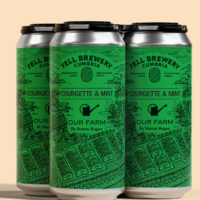
Sommeliers spend their lives opening, sniffing, pouring and tasting some of the finest wines in the world, so it’s unsurprising that many dream of making their own one day. Turning this dream into reality isn’t easy, and requires an understanding employer, killer connections and a silver tongue. With provenance having been a priority of chefs for the past decade, to the point where waiters can tell you the name of the cow behind your rib-eye, the chance for sommeliers to get closer to their product and have a hand in making it is a win-win for both the somm and the diner.
It gives the former a golden opportunity to craft a product they’ve spent their life learning about, and the latter an interesting story and added assurance of the quality of the liquid inside their chosen bottle, particularly if it’s been made by the same hands that poured it. Given the time and cost involved in making wine, the most feasible way for time-poor sommeliers to squeeze it in is by collaborating with a winemaker they’re on good terms with and renting a space in their cellar. One such sommelier is Jack Lewens, co-owner of trailblazing seasonal small plates venue Leroy in Shoreditch, which recently won a Michelin star.

This summer, Lewens released the first beautiful bottles from his Vigneti Tardis brand, a Campania-based creation made in collaboration with his long-time winemaker friend Bruno de Conciliis, who he first crossed paths with while at The River Café. Having worked as head sommelier at Ruth Rogers’ beloved Hammersmith Italian for five years, after leaving for pastures new, Lewens did his first harvest with Conciliis in 2007 and has been back each year since.
Financial backing He describes his first vintage as “the most magical thing”, as he relished being close to nature after five years of long shifts on the restaurant floor. Conciliis was the obvious choice as a collaborator for Vigneti Tardis, and Lewens admits that the project wouldn’t have been possible without him.
The venture has been financially backed by some of the most exciting names in the London restaurant scene, including Leroy co-founder Ed Thaw; the indefatigable Michael Sager of Sager + Wilde and newbie Fare Bar + Canteen in Clerkenwell; Stevie Parle of the Italian accented Rotorino and Palatino (who worked with Lewens at The River Café); and Jackson Boxer of Brunswick House in Vauxhall and St Leonards in Shoreditch, whose artist mother, Kate, designed the brand’s quirky labels.
The 2017 wines in the Vigneti Tardis range are named after days of the week in Italian – Martedi (Tuesday) is a red blend made predominantly from Aglianico, which Lewens has handled with kid gloves, using only the free-run juice to bring out its freshness and fruitiness rather than the traditional tannic power associated with the gutsy grape.
Venerdì (Friday), meanwhile, is a floral, stone fruit-scented Fiano/Malvasia skin-fermented and partially barrel-aged white blend. Both hail from a 4.5-hectare plot in Cilento national park leased from Conciliis and carry an on-trade bottle price of £45 in all of the aforementioned investors’ London restaurants, who will also be selling them by the glass at £8 a pop. Quo Vadis, The River Café and Noble Rot have also taken on the wines.
For these projects to succeed, sommeliers need to be savvy about making wines that can be bottled and listed quickly, so reds that require a long sleep in a cellar before release are out of the question. Having made just 6,000 bottles last year, Lewens is on track to produce 20,000 this year, which he plans to sell in the New York and Paris on-trade, as well as London. “Ramping up our production means there is more financial pressure on us to make sure we balance our books, so nailing the US market early will be key,” he says.

“I’ve gone in at the deep end, but it’s important that our partners have something to reward their investment quickly.”
Ever restless, Lewens is also working on a pet nat sparkler; high-end red Jovedi (Thursday), made from a stellar small parcel of Aglianico, which is due to be on Leroy’s list by Christmas priced at £60 a bottle; and a white vermouth made using a Trebbiano base, featuring botanicals foraged from Cilento national park, including three types of wormwood indigenous to Campania.
The winemaking side of things demands so much of Lewens’ attention that he’s called time on his sommelier duties at Leroy.
Having recently become a father for the first time, something had to give. “This is a long-term project, not a fly-by-night thing. We’ve leased the land for 15 years and I plan to spend up to five months a year in Italy during harvest and all the key stages of the growing season. Chefs have farms, so why can’t sommeliers have vineyards – it’s a natural progression of the provenance movement,” says Lewens, who admits to making his wines on a shoestring budget.
Taking more of a nomadic approach to winemaking is bartender-turned-sommelier Nick Jones, the self-styled ‘baron of booze’ at Soho disruptor Flavour Bastard. Keen to clock up as much winemaking experience around the world as possible with his girlfriend at the time, Plumpton graduate Jones made his first small batch of bottles in the Languedoc in 2012, leasing a tank in a garage from an old college friend.
The project lit a spark in him, and led to the formation of his peripatetic wine company WMD (Wines of Momentary Destination). “I’d just graduated and had bugger-all money but wanted to make my own wine. The idea with WMD was to make wines that were a snapshot of one place from one year all over the world,” says Jones, who admits that he found it hard being accepted into the local winemaking community in Roussillon. “I met a guy in a local pub and managed to get him drunk enough to persuade him to help me get my hands on some good quality grapes. The first few parcels he showed me were terrible wild boar-ravaged things that were never going to ripen, but I eventually managed to score some really lovely young-vine Syrah from him.”
Article continues on the next page




